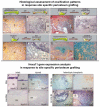Regenerative Models for the Integration and Regeneration of Head Skeletal Tissues
- PMID: 30486286
- PMCID: PMC6321600
- DOI: 10.3390/ijms19123752
Regenerative Models for the Integration and Regeneration of Head Skeletal Tissues
Abstract
Disease of, or trauma to, the human jaw account for thousands of reconstructive surgeries performed every year. One of the most popular and successful treatment options in this context involves the transplantation of bone tissue from a different anatomical region into the affected jaw. Although, this method has been largely successful, the integration of the new bone into the existing bone is often imperfect, and the integration of the host soft tissues with the transplanted bone can be inconsistent, resulting in impaired function. Unlike humans, several vertebrate species, including fish and amphibians, demonstrate remarkable regenerative capabilities in response to jaw injury. Therefore, with the objective of identifying biological targets to promote and engineer improved outcomes in the context of jaw reconstructive surgery, we explore, compare and contrast the natural mechanisms of endogenous jaw and limb repair and regeneration in regenerative model organisms. We focus on the role of different cell types as they contribute to the regenerating structure; how mature cells acquire plasticity in vivo; the role of positional information in pattern formation and tissue integration, and limitations to endogenous regenerative and repair mechanisms.
Keywords: axolotl; jaw regeneration; limb regeneration; positional information; regenerative medicine; transplantation; zebrafish.
Conflict of interest statement
The authors declare no conflict of interest.
Figures





Similar articles
-
Cartilage and bone cells do not participate in skeletal regeneration in Ambystoma mexicanum limbs.Dev Biol. 2016 Aug 1;416(1):26-33. doi: 10.1016/j.ydbio.2016.05.032. Epub 2016 Jun 14. Dev Biol. 2016. PMID: 27316294
-
Understanding positional cues in salamander limb regeneration: implications for optimizing cell-based regenerative therapies.Dis Model Mech. 2014 Jun;7(6):593-9. doi: 10.1242/dmm.013359. Epub 2014 May 28. Dis Model Mech. 2014. PMID: 24872456 Free PMC article. Review.
-
Exogenous Vitamin D signaling alters skeletal patterning, differentiation, and tissue integration during limb regeneration in the axolotl.Mech Dev. 2018 Oct;153:1-9. doi: 10.1016/j.mod.2018.08.004. Epub 2018 Aug 7. Mech Dev. 2018. PMID: 30096415 Free PMC article.
-
Complement-triggered pathways orchestrate regenerative responses throughout phylogenesis.Semin Immunol. 2013 Feb;25(1):29-38. doi: 10.1016/j.smim.2013.04.002. Epub 2013 May 17. Semin Immunol. 2013. PMID: 23684626 Free PMC article. Review.
-
Transcriptional components of anteroposterior positional information during zebrafish fin regeneration.Development. 2013 Sep;140(18):3754-64. doi: 10.1242/dev.098798. Epub 2013 Aug 7. Development. 2013. PMID: 23924636 Free PMC article.
Cited by
-
Integration failure of regenerated limb tissue is associated with incongruencies in positional information in the Mexican axolotl.Front Cell Dev Biol. 2023 Jun 2;11:1152510. doi: 10.3389/fcell.2023.1152510. eCollection 2023. Front Cell Dev Biol. 2023. PMID: 37333984 Free PMC article.
-
Post-amputation reactive oxygen species production is necessary for axolotls limb regeneration.Front Cell Dev Biol. 2022 Aug 26;10:921520. doi: 10.3389/fcell.2022.921520. eCollection 2022. Front Cell Dev Biol. 2022. PMID: 36092695 Free PMC article.
-
Cranial Neural Crest Cells Contribution to Craniofacial Bone Development and Regeneration.Curr Osteoporos Rep. 2023 Oct;21(5):624-631. doi: 10.1007/s11914-023-00804-8. Epub 2023 Jul 8. Curr Osteoporos Rep. 2023. PMID: 37421571 Review.
-
Hierarchical pattern formation during amphibian limb regeneration.Biosystems. 2019 Sep;183:103989. doi: 10.1016/j.biosystems.2019.103989. Epub 2019 Jul 8. Biosystems. 2019. PMID: 31295535 Free PMC article. Review.
References
-
- McCarthy J.G. The role of distraction osteogenesis in the reconstruction of the mandible in unilateral craniofacial microsomia. Clin. Plast. Surg. 1994;21:625–631. - PubMed
-
- Shwyrkow M.B., Shamsudinov A.K. Methods of simultaneous treatment of the mandible defects and the adjacent soft tissues. Acta Chir. Plast. 1989;31:226–235. - PubMed
-
- Komisar A. Mandibular Reconstruction. Thieme; Stuttgart, Germany: 1997.
Publication types
MeSH terms
Grants and funding
LinkOut - more resources
Full Text Sources

